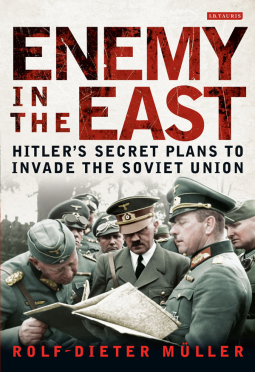
Enemy in the East
by Rolf-Dieter Müller
This title was previously available on NetGalley and is now archived.
Send NetGalley books directly to your Kindle or Kindle app
1
To read on a Kindle or Kindle app, please add kindle@netgalley.com as an approved email address to receive files in your Amazon account. Click here for step-by-step instructions.
2
Also find your Kindle email address within your Amazon account, and enter it here.
Pub Date Feb 03 2015 | Archive Date May 11 2015
I.B.Tauris | I. B. Tauris
Description
The unknown story of Hitler's plan to invade the Soviet Union
Operation Barbarossa, Hitler’s invasion of the Soviet Union in 1941, led to one of the most brutal campaigns of World War II: of the estimated 70 million people who died in the war, over 30 million died on the Eastern Front. Although it has previously been argued that the campaign was a pre-emptive strike, in fact, Hitler had been planning a war of intervention against the USSR ever since he came to power in 1933. Using previously unseen sources, acclaimed military historian Rolf-Dieter Müller shows that Hitler and the Wehrmacht had begun to negotiate with Poland and had even considered an alliance with Japan soon after taking power. Despite the signing of the Molotov-Ribbentrop Pact, at the declaration of war in September 1939, military engagement with the Red Army was still a very real and imminent possibility.
In Enemy in the East, Müller takes us behind the scenes of the Wehrmacht High Command, providing a fascinating insight into a lesser known story of World War II.
Praise for Rolf-Dieter Muller's The Unknown Eastern Front
'The Unknown Eastern Front demonstrates that history – especially of a highly sensitive issue like this one – is rarely about neat binary categories of black and white, good and evil.'
Roger Moorhouse, TLS
'In lifting the veil with which history has shrouded these men, Müller... has opened up a new vista on a largely forgotten, and sometimes deliberately neglected, but crucial aspect of recent history.'
Nigel Jones, Spectator
'...this is an important subject... [Müller] supplies full and useful detail on the contribution of all the different peoples who participated, with information on the numbers of soldiers and the tasks they were expected to fulfill.'
Richard Overy, History Today
'A definitive work.'
Die Welt
Available Editions
| EDITION | Hardcover |
| ISBN | 9781780768298 |
| PRICE | $29.00 (USD) |
Links
Average rating from 15 members
Featured Reviews
 Reviewer 205352
Reviewer 205352
Comprehensive account that convincingly punctures some previously held assumptions around the plans for the German-Soviet war.
Rolf-Dieter Müller convincingly explains that Hitler’s decision to invade the Soviet Union in 1941 was not the first time a plan had been compiled by the German High Command, but that plans had been formed going back to the early 1930s even before the Nazis came to power.
Although Jodl and Keitel paid the ultimate price at the Nuremberg Trials Müller argues that the likes of Halder and Warlimont were just as guilty, but managed to cover their tracks better.
More surprisingly the early plans had always assumed that Poland was an ally or at the very least neutral and that the campaigns would have been two pincer movements from East Prussia via the Baltic states into Northern Russia and from Rumania and Slovakia into the Ukraine.
The author describes how Hitler and the Nazis held Pilsudski, the Polish leader until 1935, in very high regard and saw Poland as a bulwark against the Soviet Union. High level diplomacy from Germany tried to convince Poland to join the Anti-Comintern Pact along with Japan and Italy.
The surprising and shocking nugget of information that underlines the closeness of Poland and Germany prior to May 1939 was that the Polish Ambassador to Germany Jozef Lipski was actively talking to the Nazis about a joint effort to exile the Polish and German Jews to Africa.
In January 1939 Hitler tried to form a military alliance with Poland, but the relationship broke down over Danzig and the Polish corridor, forcing Poland towards Britain and setting in train the German invasion of September that year. However if agreement had been reached Barbarossa or it’s 1939 equivalent could have started off with both Polish and German armies participating and with the Baltic states as yet unoccupied by the Soviet Union.
Rolf-Dieter Müller has convincingly punctured some previously held assumptions around the plans for the German-Soviet war and created a book that anyone interested in the Eastern Front should add to their bookshelves.
 Nigel M, Reviewer
Nigel M, Reviewer
A scholarly work that has to be a "must-read" for anyone with an academic interest in Hitler and his scheming! What makes it so enjoyable for the lay reader is the manner in which we are educated in the subtleties and political machinations of warfare. Of course you need the manpower, brilliant command of logistics, appropriate weaponry and a cohesive strategy but, as Muller makes clear, these are as naught if you can't build alliances, if you create confusion amongst your senior military commanders and, above all, if you let monstrous ego cloud your judgement. As a result Hitler was always doomed to fail in Russia. This excellent book educates us as to how indecisiveness and inability to build trust can cost you a victory. Read and enjoy.
‘On 22 June 1941, the German Wehrmacht and its allies began their assault on the USSR.’
Operation Barbarossa, Hitler’s invasion of the Soviet Union in 1941, let to one of the most brutal campaigns of World War II. It is estimated that of the 70 million people who died during the war, more than 30 million died on the Eastern Front. In this book, Rolf-Dieter Müller explains that Hitler’s decision to invade the Soviet Union in 1940 was based on earlier plans, some of which had been formed even before the Nazis came to power. The early plans had assumed that Poland would be at least neutral, if not an ally, and that the campaigns would have been two pincer movements: from East Prussia via the Baltic states into Northern Russia, and from Romania and Slovakia into the Ukraine. Professor Müller explains how Hitler and the Nazis held Józef Piłsudski, who led Poland until 1935, in very high regard. They saw Poland as a bulwark against the Soviet Union, and tried to convince Poland to join the Anti-Comintern Pact together with Italy and Japan.
The key questions to be addressed, identified in the introduction to this book, are:
‘When did plans for a war against the USSR emerge and become part of the Third Reich’s military deliberations? What role was played by the relationship with Poland, the ‘anti-Russian trench’? Was Hitler’s turn against Poland in spring 1939 intended to create the basis for a subsequent war in the west or in the east?’
How close were Poland and Germany before May 1939? Professor Müller writes that Józef Lipski, the Polish Ambassador to Germany: ‘.. promised Hitler ‘a nice monument in Warsaw’ if he could find a solution to the ‘Jewish question’.’ Poland and Germany were discussing a joint effort to exile the Jews of Poland and Germany to Africa. In January 1939 Hitler tied to form a military alliance with Poland, but the relationship broke down over Danzig and the Polish Corridor. This pushed Poland towards the ‘ever-greater support offered by the Anglo-Saxon powers’ and set in train the German invasion in September. If agreement had been reached between Poland and Germany in 1939, the 1939 equivalent of Barbarossa could have started with the armies of both countries participating, and with the Baltic States not yet occupied by the Soviet Union.
‘Hitler was deeply convinced in 1939 that conquering the USSR would be a piece of cake and that it would make his Third Reich unassailable for all time. An Operation Barbarossa in 1939 probably would have led to the collapse of the Soviet Union and the destruction of Russia.’
In this book, Professor Müller takes us behind the scenes of the Wehrmacht High Command. I think that anyone the history of the Eastern Front would be interested in reading this book.
Rolf-Dieter Müller is a professor of military history at Humboldt University in Berlin and serves as the Scientific Director of the German Armed Forces Military History Research Institute in Potsdam.
Note: My thanks to NetGalley and the publisher I B Tauris for the opportunity to read an advance copy of this book.
Jennifer Cameron-Smith
This book is a fascinating insight that sheds light on Hitler’s war plans and brings us behind the scenes of the Wehrmacht High Command strategy to attack the Soviet Union from the very start of World War 11 and the risky move that was “Operation Barbarossa”. “Enemy in the East” is a wealth of research into newly and forgotten documents discovered in archives and notes taken from speeches recorded during meetings Hitler had with his military strategists. At the end of the book we have a list of handy references and foot notes at bottom of pages when need be.
The plan to invade the Soviet Union was in the making long before the Nazis came to power. The author brings us back to the 1800’s and to the early 1900’s with an overview of events that took place and have influenced the “Powers that be” later on. Hitler had planned a war of intervention against the USSR long before he seized power and declared the Nazi Party the only legal political party in Germany. We have surprising information how Hitler manipulated neighboring countries into alliance and used them as bulwark against the Soviet Union.
There is a lot said in this book that I will not touch here that is most interesting and educational. To facilitate our orientation since some countries have changed names and borders since, the author has included useful maps to orient us through the maze. I was happy to have them as reference it helped immensely to understand the strategy and the movement of troops along the different corridors.
In short, the author has written a concise yet a very comprehensive analysis of the military mind-set and what motivated them to carry the Crusade against Bolshevism and the subsequent atrocities that occurred.
If you are interested in the Eastern Front War, “Enemy in the East”, is an excellent addition to any library.
My thanks to NetGalley and to the publisher I.B. Tauris for the opportunity to read an advance copy of this book.
 Donna M, Reviewer
Donna M, Reviewer
A stunning account of coalition; vacillation, and betrayal, concluding with apocalyptic Operation Barbarossa and the downfall of the Third Reich.
The narrative of the Second World War is littered with turning points. One of the most celebrated is that of Hitler's decision to invade his Soviet ally in 1941, being as it is, largely credited with the downfall of the Reich. The framework within which this decision was made in seems incredulous with hindsight, particularly when framed against the pre-existing the Molotov - Ribbentrop pact and the later backdrop of the failed Adler Tag of 1940.
Why then, would Hitler seek to invade his most-avowed enemy and creditor at a time when, strategically, Hitler was increasingly without allies? If the answer cannot be explained simply by psychosis, where can it be found? The answer to this conundrum is within the machinations of the unstable interwar world.
By using previously unseen records, the author creates an enthralling and dynamic scene of political engagements and negotiations between Germany; Poland, and Japan which sought to create both a bulwark against Bolshevik expansionism, and to provide the foundations for the eventual creation of the Lebensraum which Hitler was desperately seeking.
The politicking of the interwar period and the division of the world into communist and anti-communist spheres was built on a foundation mutual distrust and counter coalition, and the author skilfully reveals the fundamental contradiction within Nazi foreign policy which assumed the unstinting neutrality of it's partners in the face of Hitler's expansionist policies. In a post-war world which was anti communist in it's disposition, it was Hitler's inability to maintain the coalitions which had been sought and built in the interwar period which ultimately led to his nemesis.
Whilst the book doesn't concern itself with Hitler's apparent psychosis; it still paints a vivid and enthralling picture of how the Fuhrers' unrestrained campaign of duplicity, and political miscalculation forged a path leading towards the guaranteed destruction of the Third Reich, as opposed to the bread baskets; oilfields, and Lebensraum in the East that he was searching for.
Readers who liked this book also liked:
Sam Morrison
Children's Nonfiction, Crafts & Hobbies, Outdoors & Nature
Natalie Horseman
Children's Fiction, Outdoors & Nature, Parenting, Families, Relationships
Dan McCauley
Children's Fiction, Health, Mind & Body, Parenting, Families, Relationships


















